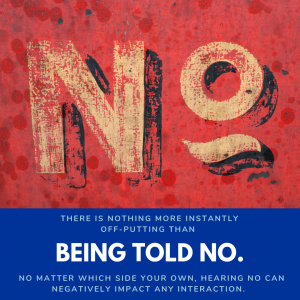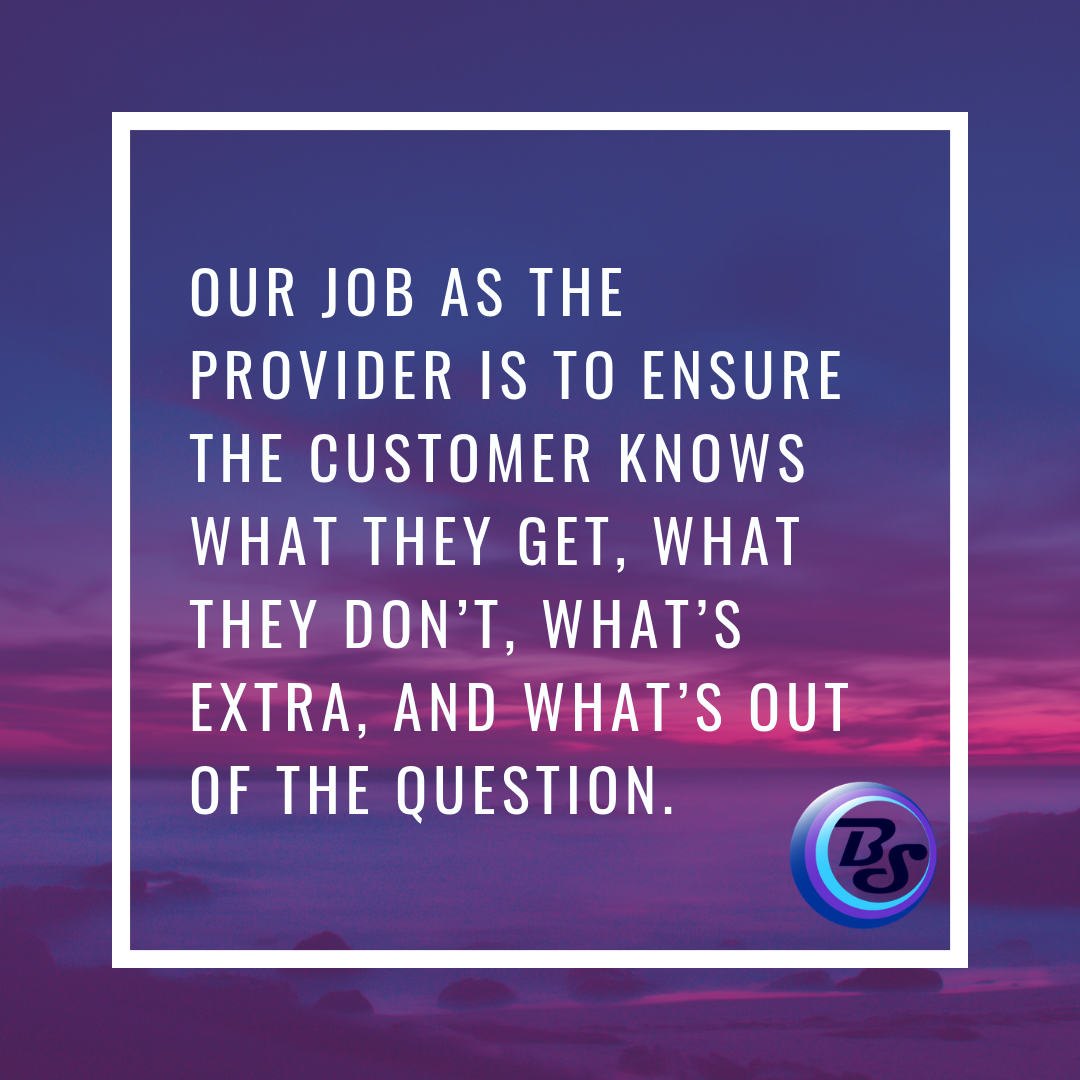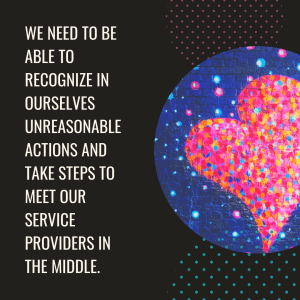We’ve all had THAT client, nightmare client relationship from hell. Heck, many of us have BEEN the customer from hell. What I’m hearing more and more from other entrepreneurs is that there has been a decline in etiquette. What used to be common-sense no longer seems common.
Today, I want to start a new trend. I want to revive business etiquette. There are three customer types that really grind my gears. I’m going to explain who they are and how to avoid both becoming and succumbing to them.
The Creepers
I’m not talking the adjective creepy but those clients that always find a way to pay the least and take the most. Also known as scope-creepers, these clients are always trying to get the extra mile out of every inch. Just one more edit, one more change, one more slight adjustment. These individuals are draining on your time, energy and resources.
The Fade-Aways
Oh the joys of the unresponsive client. The people who pop in and out of your scope on what seems like a whim. You send beautiful proposals or brilliant strategies into their endless void, never knowing if they liked it or didn’t, or even if it was read. Then one day, POOF, there they are with a string of questions or demands and no answers. You may reach the finish line with these folks… or you may end up waiting for a day that will never come.
The Mind-Readers
You can only presume that these clients are mind-readers. Why? Because they expect everyone else to be. It’s assumed that you just GET IT. Or that you should get it. You’ll hear things like, “You’re the _____, you know best” when trying to get instructions. The big reveal is that that you’ve missed capturing their vision entirely. Taxing on the nerves and the time clock, these clients can be tough to work with.
How to Handle THAT Client
We’ve established the different types of clients, next we need to address how to handle them. Masterful management of a troublesome customer cannot only save face in a bad situation though also help you understand how to avoid letting it get to that point.
The Creepers
The best defence is a good…. Defence! After dealing with a few clients who showed me the true meaning of scope creep, I took a pre-emptive approach. I make sure that everything included (and everything extra) is clearly defined. Grey areas only serve to feed and fuel creepers.
Start by putting everything in writing. I like to provide formal proposals that cover everything included, expectations, deliverables, timelines and more. Then, as an extra catch-all, I include: “*Additional services can be added based on client requirements. Any increase in quoted rate would be discussed and agreed upon in writing prior to being billed.”
From the time you start your interactions and every step of the way it’s up to us. Our job as the provider is to ensure the customer knows what they get, what they don’t, what’s extra, and what’s out of the question. Failure to do so could put you in a spot where you can’t avoid scope creep.
Make sure lines of communication are open and receptive but don’t be afraid to stand your ground. Your time and effort are valuable. If it wasn’t they wouldn’t be trying to get it for free.
The Fade-Aways
It’s hard to get a race car from start to finish without the driver. Sure, there are a lot of moving parts to a race team, but no driver means no action. It’s like having a fade-away client. It’s impossible to propel the project forward when the decision maker is the hold-up.
These folks can show their colors at any time. Sometimes, you can recognize the signs early; they don’t respond to emails or proposals, they send you short cryptic messages, they dodge any actual commitment. It’s great when this happens because you can simply choose not to work with them.
It’s a little harder if the trait doesn’t show up until you are partway through. Much like with creepers, it’s important to take precautions. Having your agreement contain deliverable dates, and what penalties will be applied for missed dates, has been a very effective tool. Either the clients get in line or they pay for the time and inconvenience they cause. Plus, it helps you enforce your own value.
Be clear and consistent. Oh, and do NOT miss a deadline yourself, or you’ve opened a whole new can of worms. Just saying.
The Mind-Readers
I’ve yet to find a way to avoid mind-readers. These folks crop up in the strangest places. I truly feel that people don’t always know what they want until you show them what they don’t. I can’t fault them per say, they don’t know any better. We’ve all picked up that cute top to try on that looks atrocious when you give it a go. It’s not always easy to put concepts into words when the concepts are foreign to you.
I tackle these clients with a combination of patience and visuals. You need to have the patience to deal with the fact that they feel frustrated about an inability to communicate what they want. You need to be able to calmly explain, show, tell, and re-explain sometimes a multitude of times before you can reach an understanding.
It’s important to keep trying to communicate. Try different ways to express similar things so that you can breach the communication gap. That’s really what it comes down to, communicating with someone who doesn’t understand your language.
How to Ensure YOU Aren’t THAT Client
Feeling confident you know how to handle THAT client when the time comes? Great, that’s what I like to hear! The thing is, for this trend to catch on, we need to address both sides of the problem. It’s not just we as business owners that need to adjust our tactics. We, as customers, need to do the same. We need to be able to recognize in ourselves unreasonable actions and take steps to meet our service providers in the middle.
The Creepers
In the moment, it can be hard to recognize when we creep up on someone else’s scope. As the customer, we’re thinking about what we need and what we want. Often, we feel that the fault of poor foresight should rest on the company we’re working with; They know best, right?
Wrong. As the customer, we need to be more understanding and solutions focused. You thought you were getting free domain hosting for life? That’s not logical. We need to understand that the businesses we deal with are filled with people who make mistakes the same as we do.
To avoid being the creeper I recommend you get more than one proposal for your projects to see what is included in any given package or service. Don’t fear playing the field. When you make your selection after your careful review, go all in. Work with them to achieve your mutual goal – the completion of your project. That’s when you both succeed.
The Fade-Aways
I’m a busy business owner, and I imagine many of you reading this are too. Sometimes, things slip through the cracks. I totally get that. It happens to the best of us. What isn’t acceptable is this epidemic I’ve been seeing where people just don’t bother.
If someone takes the time to write out a strategy proposal for you, follow up and give them an answer (for better or for worse). Leaving it open-ended might feel right for you, however, the company may not share that opinion. Be open and honest now and you’ll be able to revisit later.
Are you expected to provide copy, images, or documents for your project? Needed by a certain date? No easy answer here folks, just do it. Unless you are paying good dollars for full service, you need to put in where you’ve agreed to put in. If you struggle, connect with the service provider and talk it out. The longer you procrastinate, the harder it will be to finish. Put it on your calendar and get it done. It could be your dollars you are wasting in the end.
A lack of communication can sour or kill any project, deal or relationship. Humans are communicative in nature. When either side feels unheard or disrespected, it can taint everything. A company will go above and beyond for a good, cooperative client. Why would you want to be anything else?
The Mind-Readers
Not knowing what we want is alright. There may be times when we learn what we want along the way. If that’s the case, be respectful to the provider and the work they have done. They couldn’t possibly expect your pivot, even if you feel it’s justified.
Want to take it to the next level? Getting a website done? Look at what you like and what you don’t. Looking for a new brand? Find some examples of brands that speak to you and brands that don’t so the provider can see what you see. Going in prepared will reduce mind-reader syndrome greatly.
I know there will be times when I’m going to rely on my experts to steer me in the right direction. When these situations occur, I commit to trusting them. It may not be my exact vision, because I didn’t have ion until I saw what was done, though it was likely well thought out. Don’t get confrontational, praise what has been done, and offer suggestions as to what you’re starting to understand as your vision.
Not-so-common Common-Sense
Outside of the big 3 are smaller etiquette considerations I think both sides of the spectrum need to observe. I feel that these small shifts to all our interactions could make a huge difference.
The 24-Hour Response Rule
We all get the same 24 hours in a day. For many, efficiency plays a major role in profit margins. Around our office, we strive for a response to all calls or emails within 24 business hours. During busy periods, those responses may be as simple as letting another person know you got the message and when you’ll respond.
This isn’t a potential mating partner, this is business. You don’t need to wait 3 days to call. (In fact, I highly recommend you don’t!) When time is of the essence, you need to be timely in all things. Set a standard time frame in which all communications are addressed and stick to it. Your customers (or providers) will thank you.
Striking “NO” from the Dictionary
There is nothing more instantly off-putting than being told no. No matter which side your own, hearing NO can negatively impact any interaction. Realizing there are situations where saying yes is impossible, it really comes down to learning the correct way to decline something.
Your client wants another round of edits for free and you can’t accommodate? That’s alright, don’t focus on what you can’t do, focus on what you can do. “We would be happy to complete an additional round of edits for you at the agreed upon rate of…”.
Let’s say your agreement states you need payment to proceed however you have a potential client wanting designs right now, no agreement, no payment, no details. Given how many times you were met with no, it’s tempting to say, no you won’t do the work. Instead, offer that perhaps you aren’t the best fit and provide a potential reference. The no is inherent, it doesn’t need to be said.
Slight adjustments to remove certain trigger words (like no) can greatly improve relations – try it.
Do What You Say
This is the biggest reason a not-so-common common-sense section even exists here. Personally, I think this is a no-brainer in business. If you say you’re going to do something, f$%^ing do it. Set a meeting? Be on time. Agreed to prompt response, get in gear. Promised to deliver a product on a certain date? Come hell or high water you need to try and meet that. The most important part of building trust is doing what you say when you say it. Break it and you break the trust. No trust means no buy. Bye bye client!
Sure, sometimes things don’t work and you’ll have to make concessions to recoup. The important thing is always striving to do what you say. When I was working for the man, I learned a few fun acronyms that helped.
We were taught that we should strive to UPOD, never OPUD. Always “Under Promise, Over Deliver” rather than “Over Promise, Under Deliver”. Try providing clients with your stretch dates, while you reach original goals. If I plan on having a report by Friday to a client, I tell them to expect it by Monday (my very latest due by). Then, when I send that report on Friday, the client is happy and feels you’ve exceeded expectations.
No matter the side I’m on, I use this principle. Always strive to exceed the expectations of the other person in your engagement and you’re sure to see success.

It All Comes Down to This
I don’t want to work with THAT client, nor do I want to be one. Therefore, I need to be making every effort to uphold the standards of business etiquette I was raised with. Be a good person, communicate well, work through understandings, and general respect the other persons time and efforts.
If we can all agree to do these things, and to be aware of when we become creepers, mind-readers or fade-aways, everyone will enjoy more positive interactions. There’s no much BS and negativity, will you commit to making your business dealings a little brighter?
~Sacha B.




Recent Comments